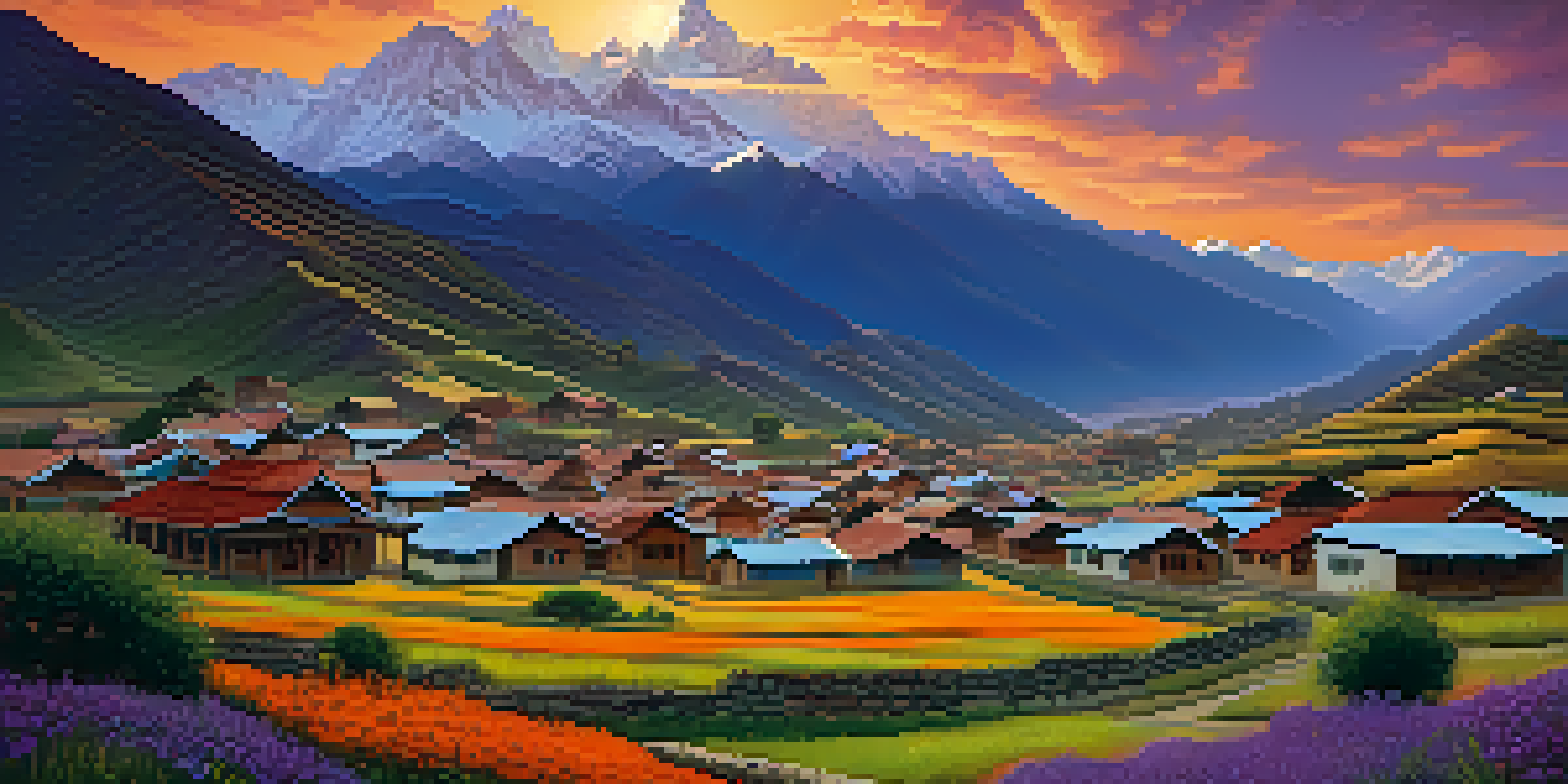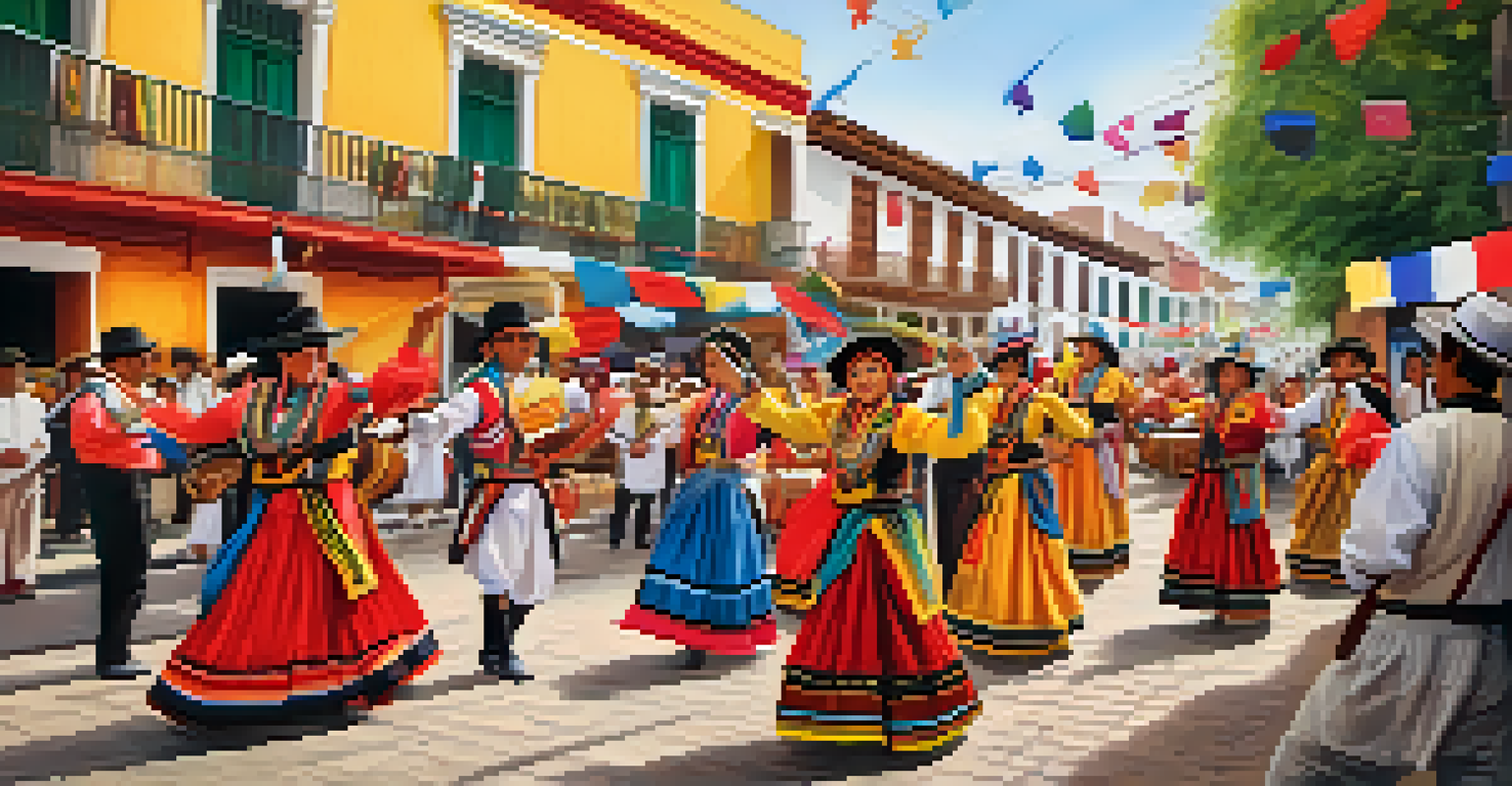The Evolution of Peruvian Poetry from the 20th Century

Introduction to Peruvian Poetry in the 20th Century
The 20th century marked a significant turning point for Peruvian poetry, reflecting the nation's complex cultural landscape. Poets began to explore themes of identity, politics, and social change, influenced by historical events like the civil conflicts and the rise of modernism. This period not only saw a diversification of voices but also a blending of traditional and contemporary styles.
Poetry is the language of the heart, and it speaks to the complexities of our identities and experiences.
One of the standout characteristics of this era was the embrace of new poetic forms, which allowed poets to express their ideas more freely. The influence of European and Latin American movements also played a crucial role, as poets sought to innovate beyond the classical forms of their predecessors. This experimentation paved the way for a vibrant poetic scene that resonated with both local and universal themes.
As we delve deeper into this evolution, it becomes clear how the socio-political climate shaped the works of many poets. This exploration will highlight the key figures who emerged during this transformative period and the lasting impact they had on Peruvian literature.
The Modernist Influence on Peruvian Poetry
Modernism, which flourished in the early 20th century, greatly influenced Peruvian poetry, introducing fresh perspectives and innovative techniques. Poets began to break away from traditional forms, experimenting with free verse and avant-garde styles. This movement emphasized individual expression and the exploration of new subjects, such as urban life and existential themes.

Notable figures like César Vallejo and José Carlos Mariátegui emerged during this time, crafting works that challenged societal norms and addressed the human condition. Vallejo's poetry, in particular, is known for its deep emotional resonance and profound philosophical inquiries. His exploration of suffering and solidarity would later inspire generations of poets.
20th Century: A Poetic Revolution
The 20th century marked a significant transformation in Peruvian poetry, characterized by a blend of traditional and modern styles that addressed themes of identity and social change.
Modernism laid the groundwork for subsequent poetic movements in Peru, encouraging poets to engage with both local and global issues. The blending of personal and collective experiences became a hallmark of this era, allowing poets to forge connections with their readers through shared struggles and aspirations.
The Boom Generation and Its Impact
The Latin American literary boom of the 1960s and 70s also had a significant impact on Peruvian poetry, bringing international attention to the region's writers. This period saw the emergence of a new generation of poets who were deeply influenced by the narrative techniques and themes explored by their prose counterparts. The blending of poetry and narrative opened up new avenues for expression.
The role of the poet is to be a witness to the world, to use their voice for those who cannot speak.
Poets like Blanca Varela and Javier Heraud emerged during this time, contributing to the dynamic landscape of Peruvian literature. Varela's work often reflects a deep introspection and a keen awareness of the social realities surrounding her, while Heraud's poetry is infused with a sense of urgency and a call to action. Their voices resonated with a generation grappling with the political upheavals of the time.
The boom generation not only revitalized Peruvian poetry but also challenged poets to engage critically with their society. This period fostered a sense of collaboration among writers, leading to a rich dialogue that explored the intersections of art, politics, and identity.
Post-Boom: A New Wave of Voices
Following the boom, the late 20th century witnessed the rise of a new wave of Peruvian poets who sought to carve their own identities amid shifting cultural landscapes. This era was characterized by a more personal and introspective approach to poetry, often reflecting the complexities of postmodern society. Emerging poets began to explore themes related to globalization, diaspora, and the fluidity of identity.
Writers like Jorge Eduardo Eielson and Marisol de la Cadena challenged traditional notions of poetry, often incorporating elements from visual art and performance into their works. Their innovative approaches encouraged a rethinking of what poetry could be, breaking down barriers between different artistic forms. This experimentation fostered a rich tapestry of poetic expression that resonated with contemporary audiences.
Modernism's Lasting Influence
Modernism introduced innovative techniques and themes to Peruvian poetry, encouraging poets to explore individual expression and engage with societal issues.
The new wave of voices also emphasized the importance of indigenous and marginalized perspectives, bringing attention to the diverse cultural heritage of Peru. This inclusivity enriched the poetic landscape, allowing for a broader range of experiences and narratives to be shared and celebrated.
Themes of Identity and Social Justice
A dominant theme in contemporary Peruvian poetry is the exploration of identity and social justice. Poets are increasingly addressing issues of race, gender, and class, using their work to challenge systemic inequalities. This focus on social justice resonates with a younger generation that seeks to understand their place within a rapidly changing world.
For instance, poets like Gabriela Wiener and Renato Cisneros have become voices for the marginalized, weaving personal narratives with broader societal critiques. Their poetry often highlights the struggles faced by those on the fringes, making the personal political. This intersection of identity and activism has allowed poetry to serve as a powerful tool for social change.
By confronting uncomfortable truths and giving voice to the unheard, contemporary poets are not only reshaping Peruvian poetry but also igniting conversations about justice and equity. Their works inspire readers to reflect on their own identities and consider the collective responsibility we share in promoting social change.
Digital Spaces and the Future of Peruvian Poetry
As technology continues to evolve, so does the landscape of Peruvian poetry. The rise of digital platforms has created new opportunities for poets to share their work with a wider audience. Social media, blogs, and online journals have become vital spaces for poets to engage with readers and fellow writers, fostering a sense of community that transcends geographical boundaries.
This shift has also encouraged experimentation with different formats, such as spoken word and multimedia poetry, allowing poets to reach audiences in innovative ways. The accessibility of digital tools has empowered a new generation of writers, many of whom are using their platforms to address pressing social issues and connect with diverse audiences. This democratization of poetry amplifies voices that may have otherwise gone unheard.
Emerging Voices in Digital Age
The rise of digital platforms has empowered a new generation of Peruvian poets, fostering diverse voices and innovative formats that address contemporary social issues.
Looking ahead, the future of Peruvian poetry appears bright, with an ever-expanding array of voices and styles. As poets continue to explore the intersections of technology and art, they will undoubtedly shape the poetic landscape in exciting and unpredictable ways, ensuring that Peruvian poetry remains a vibrant and vital part of the literary world.
Conclusion: The Ongoing Journey of Peruvian Poetry
The evolution of Peruvian poetry from the 20th century to the present day reflects a rich tapestry of cultural influences, personal experiences, and social movements. Each era has contributed unique voices and perspectives, enriching the poetic landscape of the nation. From the modernist innovations to the contemporary explorations of identity and justice, Peruvian poetry continues to adapt and thrive.
As we reflect on this journey, it is essential to recognize the interconnectedness of past and present poets and the impact of their work on future generations. The dialogue between different styles and themes showcases the dynamic nature of poetry as an art form, allowing it to remain relevant in today's world. Each poet adds a thread to the larger narrative, weaving together personal and collective stories.

In conclusion, the evolution of Peruvian poetry is an ongoing journey, one that invites readers and writers alike to engage with the complexities of identity, culture, and social justice. As we celebrate the past and embrace the future, we look forward to the continued growth and transformation of this vibrant literary tradition.